Gold Key Entertainment
Jump to navigation
Jump to search
Logo descriptions by Kris Starring, BenderRoblox, Jason Jones, Shadeed A. Kelly, and Andrew Batstone
Logo captures by Jason Jones, Shadeed A. Kelly, and Eric S.
Editions by BenderRoblox and Shadeed A. Kelly
Video captures courtesy of JohnnyL80, Eric S., and Stephen Cezar
Background: Gold Key Entertainment was a television distribution company founded in 1970 by Harold Goldman. In 1971, Gold Key merged with the Vidtronics Company, a subsidiary of the Technicolor Corporation. On January 10, 1980, Gold Key Entertainment established "Gold Key Media", a barter division to syndicate new series. In 1983, Technicolor was bought by financier Ronald Perelman's company, MacAndrews & Forbes, and Vidtronics was subsequently sold to Compact Video (which was later itself acquired by Perelman). On February 13, 1984, Four Star International acquired Gold Key Entertainment. After Compact shut down, its remaining holdings (which also included Four Star International) were folded into Perelman's Andrews Group, and eventually became part of New World Entertainment when Perelman acquired that company in 1989.
1st Logo
(1971-1980)
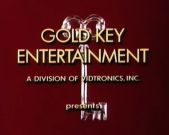
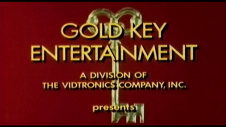
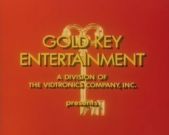
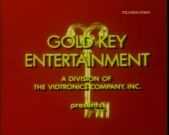
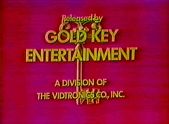
<iframe frameborder="0" height="121" src="http://wikifoundrytools.com/wiki/closinglogos/widget/genericvideo/5e12a102aabbfc92915a2487c514d1b3e433c0a5" width="159"></iframe><iframe frameborder="0" height="120" src="http://wikifoundrytools.com/wiki/closinglogos/widget/genericvideo/9b34e8e1cc9a43f613863d7ce3b7c0c90f356428" width="162"></iframe>
Nicknames: "The Flipping Gold Key", "The Color Changing Key"
Logo: Up against a red background, we see a white line that "streaks in" in the middle of the screen, making a 90 degree turn to reveal the shape of a two-dimensional key. The design then turns itself into a golden key with the following gold text fading-in front of it:
in Century Gothic font.
Variant: The closing of the presentation would have the word "Released by" above the logo text and the byline reading as: "A DIVISION OF THE VIDTRONICS CO., INC." below. The entire text is in Century Gothic Bold font.
FX/SFX: The key turning, and the key turning gold.
Music/Sounds: A bombastic fanfare, sourced from the KPM library track "Fanfare (1)" composed by Neil Richardson and released on the 1970 album Scenesetters, Fanfares, and Punctuations (catalog number KPM 1057).
Music/Sounds Variant: A low-tone version exists.
Availability: Extremely rare.
Editor's Note: It's typically rough '70s animation for the key dropping into view and turning, but the fanfare does at least gives it a grandieur feel.
2nd Logo
(1980-1983)
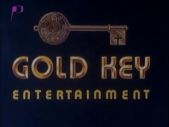
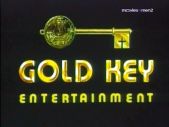
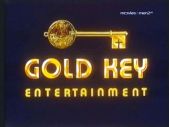
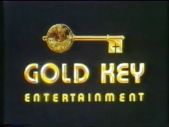
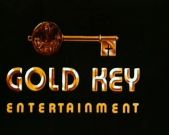
<iframe frameborder="0" height="120" src="http://wikifoundrytools.com/wiki/closinglogos/widget/genericvideo/3e36433499a883330caa30bb9121df83fd4d9fc2" width="162"></iframe><iframe frameborder="0" height="120" src="http://wikifoundrytools.com/wiki/closinglogos/widget/genericvideo/bbab9a542358713b67c4f5cd6cb5c7186fbef0ad" width="157"></iframe>
Nickname: "The Spinning Key"
Logo: Over a black background, we see a golden key spinning counter-clockwise towards us. It then makes a stop and backs up slightly off center as the words "GOLD KEY" also in gold, slide in from underneath. The word "ENTERTAINMENT" appears right under that as the logo shines throughout.
FX/SFX: The key spinning and the words sliding in from underneath.
Music/Sounds: A bombastic but somewhat majestic fanfare. It is sourced from the second track titled "Endeavour" (the 28 second version) on the Bruton Music album Important Project/Wonders of the World/Endeavour (BRJ 3), composed by John A. Coleman and released in 1978. It could also have been taken from another edit of "Endeavour" released on the album Jingles Volume One (BRB 1). Regardless of the source, the fanfare is a more specific edit of the track used for the second half of the first ITC Film Distributors logo.
Availability: Extremely rare. This appeared on various theatrical and TV movies. This is still preserved (off centered) on the DVD print of Getting Wasted (a film featuring an early performance by David Caruso).
Logo captures by Jason Jones, Shadeed A. Kelly, and Eric S.
Editions by BenderRoblox and Shadeed A. Kelly
Video captures courtesy of JohnnyL80, Eric S., and Stephen Cezar
Background: Gold Key Entertainment was a television distribution company founded in 1970 by Harold Goldman. In 1971, Gold Key merged with the Vidtronics Company, a subsidiary of the Technicolor Corporation. On January 10, 1980, Gold Key Entertainment established "Gold Key Media", a barter division to syndicate new series. In 1983, Technicolor was bought by financier Ronald Perelman's company, MacAndrews & Forbes, and Vidtronics was subsequently sold to Compact Video (which was later itself acquired by Perelman). On February 13, 1984, Four Star International acquired Gold Key Entertainment. After Compact shut down, its remaining holdings (which also included Four Star International) were folded into Perelman's Andrews Group, and eventually became part of New World Entertainment when Perelman acquired that company in 1989.
1st Logo
(1971-1980)





<iframe frameborder="0" height="121" src="http://wikifoundrytools.com/wiki/closinglogos/widget/genericvideo/5e12a102aabbfc92915a2487c514d1b3e433c0a5" width="159"></iframe><iframe frameborder="0" height="120" src="http://wikifoundrytools.com/wiki/closinglogos/widget/genericvideo/9b34e8e1cc9a43f613863d7ce3b7c0c90f356428" width="162"></iframe>
Nicknames: "The Flipping Gold Key", "The Color Changing Key"
Logo: Up against a red background, we see a white line that "streaks in" in the middle of the screen, making a 90 degree turn to reveal the shape of a two-dimensional key. The design then turns itself into a golden key with the following gold text fading-in front of it:
GOLD KEY
ENTERTAINMENT
A DIVISION OF
THE VIDTRONICS COMPANY, INC.
presents
ENTERTAINMENT
A DIVISION OF
THE VIDTRONICS COMPANY, INC.
presents
in Century Gothic font.
Variant: The closing of the presentation would have the word "Released by" above the logo text and the byline reading as: "A DIVISION OF THE VIDTRONICS CO., INC." below. The entire text is in Century Gothic Bold font.
FX/SFX: The key turning, and the key turning gold.
Music/Sounds: A bombastic fanfare, sourced from the KPM library track "Fanfare (1)" composed by Neil Richardson and released on the 1970 album Scenesetters, Fanfares, and Punctuations (catalog number KPM 1057).
Music/Sounds Variant: A low-tone version exists.
Availability: Extremely rare.
- This appeared on '70s/'80s syndication prints of the King Features cartoon library, the syndicated Krofft Superstars (featuring H.R. Pufnstuf, The Bugaloos, Land of the Lost, and other Sid & Marty Krofft series), and various theatrical and TV movies.
- This currently appears on the Rhino DVD and public domain prints of Road to Nashville.
- An abridged version of the closing variant appears at the start of the VCI release of Once Upon a Brothers Grimm.
Editor's Note: It's typically rough '70s animation for the key dropping into view and turning, but the fanfare does at least gives it a grandieur feel.
2nd Logo
(1980-1983)





<iframe frameborder="0" height="120" src="http://wikifoundrytools.com/wiki/closinglogos/widget/genericvideo/3e36433499a883330caa30bb9121df83fd4d9fc2" width="162"></iframe><iframe frameborder="0" height="120" src="http://wikifoundrytools.com/wiki/closinglogos/widget/genericvideo/bbab9a542358713b67c4f5cd6cb5c7186fbef0ad" width="157"></iframe>
Nickname: "The Spinning Key"
Logo: Over a black background, we see a golden key spinning counter-clockwise towards us. It then makes a stop and backs up slightly off center as the words "GOLD KEY" also in gold, slide in from underneath. The word "ENTERTAINMENT" appears right under that as the logo shines throughout.
FX/SFX: The key spinning and the words sliding in from underneath.
Music/Sounds: A bombastic but somewhat majestic fanfare. It is sourced from the second track titled "Endeavour" (the 28 second version) on the Bruton Music album Important Project/Wonders of the World/Endeavour (BRJ 3), composed by John A. Coleman and released in 1978. It could also have been taken from another edit of "Endeavour" released on the album Jingles Volume One (BRB 1). Regardless of the source, the fanfare is a more specific edit of the track used for the second half of the first ITC Film Distributors logo.
Availability: Extremely rare. This appeared on various theatrical and TV movies. This is still preserved (off centered) on the DVD print of Getting Wasted (a film featuring an early performance by David Caruso).
Editor's Note: While the animation's rough and some might be surprised for the darkness, spinning key, and music, it's also a favorite due to the music.